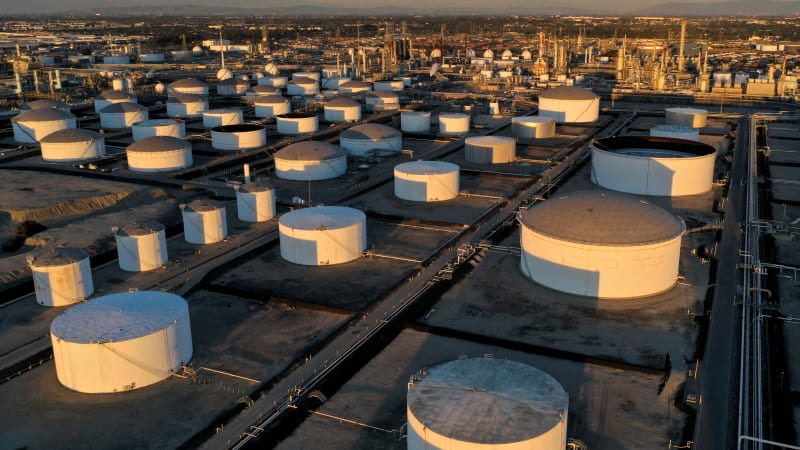Rick Newman is a senior columnist for Yahoo Finance.
U.S. oil production recently hit a new record high
. There’s a good chance you’ll never hear
President Biden mention it.
Domestic oil production has crept up to 13.2 million barrels per day, slightly above the prior record high of 13.1 million barrels in 2020, right before the COVID pandemic hit. It’s likely to drift higher still in 2024. You might think you’re hearing this wrong. So to reiterate: Yes, the United States is producing more oil under President Biden than it did under President Trump.
That wasn’t supposed to happen. Biden campaigned for the White House by vowing to “end fossil fuel.”
One of his first acts as president was to
cancel the permit for the Keystone XL pipeline that would have carried Canadian oil to refineries on America’s Gulf Coast. Biden is a champion of renewable energy who proved it by signing into law the
biggest set of green energy incentives in American history last year.
So Biden would suddenly sound like a fossil fuel cheerleader if he boasted about record levels of oil production under his watch. He’d also upset liberal Democrats who pushed for the “green new deal,” which would have gone a lot further than Biden has gone in forcing the U.S. economy off of fossil fuels. The best Biden can probably do is remind Americans when energy prices fall, while continuing to tout his green energy agenda, which may not be a resounding sell to the moderate swing voters likely to determine whether Biden gets a second presidential term next year.
Yet Biden has clearly learned how important fossil fuels are to his standing with voters, and to his political future. Biden’s approval rating sank as inflation begin to rise in late 2021 and 2022. The high point for inflation was a low point for Biden. The overall inflation rate hit 9% in June 2022, the same month U.S. gasoline prices hit $5 per gallon, the highest level ever. Pump prices have since come down — the current national average for a gallon of regular is $3.40 — but Biden’s approval rating has never recovered.
Biden has spent much of his presidency trying to manage gasoline prices. His administration sold 180 million gallons of oil from the nation’s strategic reserve, to boost global supplies and bring prices down. That brought the reserve to the lowest level since 1984. He and his deputies tried to jawbone US drillers into producing more, but private-sector energy companies aren’t answerable to the president. They’re answerable to investors and shareholders eager to lock in profits instead of putting more money into production, risking oversupply.
Biden has also tried to get foreign drillers, such as Saudi Arabia, to produce more oil, without much luck. The Saudis and other member nations of the oil-exporting group OPEC have been cutting production, not boosting it. In October, the Biden administration even eased sanctions on dictatorial Venezuela, hoping to squeeze a few more barrels out of the oil-rich nation, even though its energy infrastructure is in shambles.
[Drop Rick Newman a note, follow him on Twitter, or sign up for his newsletter.]
The market is now accomplishing what Biden couldn’t. U.S. drillers are producing more energy because they can make more money doing it. Oil prices crashed during the COVID pandemic, even turning negative for a brief time as there was more oil in storage than anybody knew what to do with. But they’ve since recovered to a range of $75 to $95 per barrel. U.S. drillers can make healthy profits at those levels. The OPEC production cuts are actually benefiting US energy firms by keeping prices high enough to make more drilling profitable.
Another happy fact Biden will probably never tout: The United States is the world’s top oil producer. That has been the case since 2018, due to new horizontal fracking technology that made vast amounts of energy, much of it in Texas, newly accessible. As OPEC nations produce less, U.S. barrels become more important to the global market.
Is the boom in U.S. oil production bad news for efforts to wean the world off fossil fuel and address global warming?
There are two ways to look at it. Some environmentalists want to speed the transition to renewables by forcing cuts in the supply of fossil fuels, so that renewables are the only option for some consumers. That’s imprudent, because there’s a good chance it will raise prices for end users if renewables aren’t cost-competitive with fossil fuels, which they aren’t in many places, such as areas where wind and solar aren’t yet wired into the grid.
Biden has discovered the political peril that can come with imposing limits on fossil fuels. Canceling the Keystone XL pipeline in 2021 had no effect on oil or gasoline prices, since the pipeline wasn’t even built and no oil was moving through it. But Biden took a public stance in opposition to fossil fuels, and when gas prices spiked in 2022, consumers blamed him. Biden asked for it.
A better approach to accelerating the green energy transition is doing everything feasible to bring more renewables to market, so that scaling up production helps lower costs and makes renewables cost-competitive with fossil fuels. This is exactly what Biden’s green energy incentives are doing, by effectively lowering the break-even point for green energy production and drawing more investors into the business, to boost supply.
